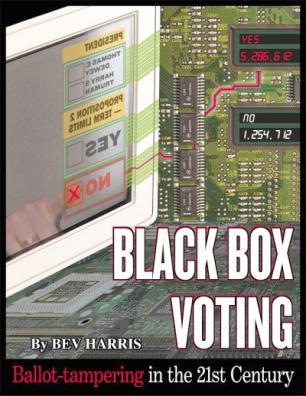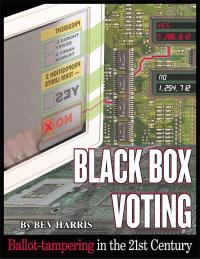Bev Harris: Diebold Voting Machines Phone Home
Electronic Voting Machines: Oooof! Here’s proof -- NEW, from the Diebold files
3:31 p.m., five hours before poll closing: Diebold voting machines “CALLED HOME”
Wednesday, 03 September 2003 (PDT)
By Bev Harris – blackboxvoting.org
MORE: http://www.blackboxvoting.org/JimMarch.htm

http://www.blackboxvoting.com
Read The Book…Support The Cause - Pre-Order Your Copy
Today
What happened at 3:31 p.m. on election day in San Luis Obispo County California? A file from the Diebold stash examined by Jim March, of Alameda County California, turns out to be from a real election, and it contains real votes. And it also contains a real problem for Diebold, because it is illegal to count the votes before the polls close. Even more interesting: What mechanism was used to get votes to migrate from 57 polling places into a central tally in the middle of the afternoon?
Activist Jim March put the files on a NEW web site containing a selection of the Diebold files, designed so that you can create a demo CD and personally demonstrate the security flaws to reporters and your local election officials: http://www.equalccw.com/dieboldtestnotes.html (NOTE: The index page for these downloads will be archived at Scoop)
Says March to Diebold: “You are cordially invited to bite me. Bring it on. Make my day!”
(See also: http://www.blackboxvoting.org/JimMarch2.htm: “Why Diebold isn’t going to sue me.”)
For some reason, the Diebold optical scan machines in 57 precincts simultaneously had an E.T. moment. They “called home” with election results while the election was still in progress, summing up the votes in 57 precincts, then tagged the file to a Diebold employee and placed it on a Diebold company web site.
This file is from the 2002 primary election in San Luis Obispo, California. It is dated March 5, 2002. It is date and time-stamped, and contains an internal audit log which confirms the date and time. It was saved as a “backup file” at exactly 3:31 p.m. on election day, about five hours before the polls closed.
This file contains a tabulation taken from 57 precincts. The votes in the file correspond with the final vote tally, which can be found on the San Luis Obispo County web site for that election -- but only about 40 percent of the votes had come in by 3:31 in the afternoon.
This file was put on the Diebold FTP site used by Diebold employees to transfer files. Why? It is against the law to count votes before the polls close.
(Was this file used for training?)
No one trains poll workers during election day. And why would you use real votes and a real file, during the middle of an election, for training?
(Was this file part of a “Logic and Accuracy test?”)
It was date and time-stamped at 3:31 on election day. L&A tests are done a few days before the election.
(Did they set the date forward for a Logic and Accuracy test?)
The audit log shows that this it was an election, not a test. When an L&A test is done, the machine is set into a test mode. The audit log reflects the test mode.
(Maybe the clock was off? It was for a different time zone? When it said 3:31 it was 8:31?)
Checking the date and clock is part of the election procedures, marked “important.” But more than that, after the polls closed there were more votes! About 18% of registered voters had cast votes as of 3:31 p.m., but the final number for the primary was about 35%. Therefore, the 3:31 vote tally was taken partway through the election.
(How do the votes correspond to the final vote tally?)
The voting pattern is essentially the same as the final tally, but there are fewer votes at 3:31 p.m.
(How did they add up all the votes in the middle of the day?)
The answer to this question raises more questions:
There are only three ways to get a central tabulation of 57 precincts in the middle of the day:
1) You can shut down the optical scan machine at each polling place, remove the vote database, which is stored on a memory card, get in your car, and drive the curvy California seacoast roads to the county office, give the card to the elections registrar, who will then load 57 precinct cards one by one onto the GEMS central counting system and tally them up. Then you can pick up the cards, get back in your car, and drive back to the polling place, restart the machines, and let people start voting again. Fifty-seven precincts would have to do this at once.
2) You can shut down the machines at 57 precincts, plug in a phone modem, and modem the results into the county server computer (which has the GEMS tabulation program on it), and add up the 57 precincts at 3:31 in the afternoon, giving you an illegal tally taken during the middle of an election.
3) While the machines are running, if they are connected to either a land line or wireless communication card, you can gain entry, either by an outside hack or by a Diebold technician using inside knowledge. You collect the data from the machines using remote access while the election is in progress, and tabulate it on your own computer using a copy of the GEMS program (readily available to anyone from the unprotected Diebold web site).
Although Diebold has claimed modem connections are one-way (but the machines must handshake and that creates a two-way pipeline for information), because it’s two-way, you can use the same method you used to gather the votes up to send data back into the voting machine. You can even erase the evidence that you accessed the machines.
But now Diebold and the county elections registrar claim that the optical scan machines are not hooked up to a modem at all. This is a recent development; interviews as late as February 2003 say the machines are equipped for remote communication, and so do the hardware and user manuals. However, if the machines aren’t hooked up, this leaves only option 1) Have all 57 precincts shut down the polls and drive in to the county office in the middle of the day.
(But there are paper ballots with an optical scan machine.)
Yes, but only one-half percent of the precincts in California are audited by looking at the paper ballot. It is illegal to count the paper ballots except in unusual circumstances, usually requiring a court order. Your chances of slipping by the paper ballot spot check are 99.5 percent. And if you do get audited, you can say it was a “computer glitch” and you’ll have the tech look into it. Enter the words “election” and “glitch” in Lexis-Nexis and you will find hundreds of “glitches,” many of which change the outcome of elections, even when the elections were not particularly close.
MORE
The tabulation was saved to a backup file labeled “ORIG” (original votes?). It was assigned a password and placed on a Diebold-owned web company web site. The password was: “Sophia.” Sophia Lee was a Diebold employee.
Pardon me, but what were they doing with this file again? Did Diebold steal voting information from San Luis Obispo County, or did the San Luis Obispo County Elections Registrar produce an illegal midday tally? Who did this? Was Sophia there that day? If these were the “original” votes what votes were put into the final votes?
And perhaps most important: What mechanism was used to enable votes to migrate from 57 precincts into someone's central tally at 3:31 in the afternoon on election day?
Bev Harris is author of
Black Box Voting: Ballot Tampering In The 21st Century
… See
http://www.blackboxvoting.com/ and it's activist arm
http://www.blackboxvoting.org/ For more
background and live news links on this news subject see also
Scoop's Special Feature – A Very American
Coup…
Pre-Order your copy
of Black Box Voting today…
---
NOTE TO SCOOP EMAIL SUBSCRIBERS... THIS HAS BEEN POSTED AS A
SPECIAL ITEM TO THE SLUDGE REPORT MAILING LIST
---


 Binoy Kampmark: Authoritarian Politics - Netanyahu’s War On Israeli Institutions
Binoy Kampmark: Authoritarian Politics - Netanyahu’s War On Israeli Institutions Keith Rankin: Learning The Correct Lessons From World War Two In Europe
Keith Rankin: Learning The Correct Lessons From World War Two In Europe Ramzy Baroud: Arab Failures - The Unspoken Complicity In Israel's Genocide
Ramzy Baroud: Arab Failures - The Unspoken Complicity In Israel's Genocide Peter Dunne: Dunne's Weekly - The 'War On Woke' Is Really Just A 'War Of Words'
Peter Dunne: Dunne's Weekly - The 'War On Woke' Is Really Just A 'War Of Words' Gordon Campbell: On Israel’s Murderous Relapse, And Peters’ Sad Decline
Gordon Campbell: On Israel’s Murderous Relapse, And Peters’ Sad Decline Howard Davis: An Inconvenient Truth Revisited
Howard Davis: An Inconvenient Truth Revisited